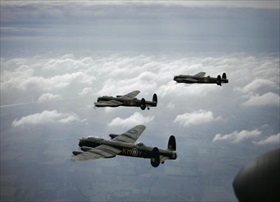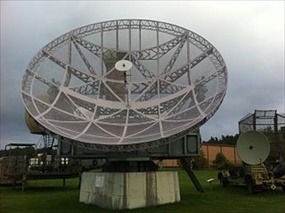BRITISH BOMBERS ATTACK GERMAN RADAR FACTORY
RAF Scampton Airfield, Lincolnshire, England • June 20/21, 1943
On this date in 1943 a Royal Air Force bomber task force of Avro Lancasters took off from Scampton and several other Lincolnshire airfields on a mission to bomb a German radar-antenna factory at Friedrichshafen on the northern shore of Lake Constance (German, Bodensee) in the extreme south of the country. Earlier in the month RAF photo-reconnaissance planes had flown over the dirigible hanger and storage yard of the former Zeppelin Works (German, Luftschiffbau Zeppelin) at Friedrichshafen and photographed an outdoor stack of metal latticework called “ribbed baskets” in the report. Later analysis identified the metal latticework as components of Telefunken’s 24 ft (7.3 m) Giant Wuerzburg (Wuerzburg Riese) fine-mesh parabolic radar reflectors (radar antenna). (Telefunken was a major player in Germany’s radio and electronics fields, both civilian and military.) RAF intelligence recognized the metal latticework for what it was partly owing to Operation Biting, a raid British commandos had pulled off in February 1942 when they retrieved components of a smaller operational early-warning Wuerzburg radar installation near Bruneval in Northern France. British Prime Minister Winston Churchill took a strong interest in the recon photos and ordered Operation Bellicose into existence for the purpose of destroying the ex-Zeppelin factory and storage yard.
Sixty long-range RAF Lancasters flying low on the moonlit night of June 20/21, 1943, hit Friedrichshafen’s Wuerzburg radar-antenna factory multiple times, setting off bright fires and explosions felt 10 miles away. Thirteen minutes after arriving over Friedrichshafen the British warriors turned southeastward, flying across Switzerland, Austria, Northern Italy, and the Mediterranean Sea to land on the morning of June 21 at a U.S. air base in Algeria, North Africa to rearm and refuel. (The Brits’ flight plan fooled the Luftwaffe, which marshalled night fighters over Eastern France to catch the Lancasters returning to England.) Fifty-two Lancasters that needed no repairs in North Africa retook to the sky to attack oil and armaments stores at the Italian naval base of La Spezia on June 23 on the return leg to their home bases. Operation Bellicose thus became the first “shuttle bombing” raid of World War II as well as the first shuttle raid to suffer no aircraft losses to enemy fire.
Sir Arthur Harris, Air Officer Commanding-in-Chief RAF Bomber Command, toasted Operation Bellicose as twice the hoped-for success he wanted. Besides damaging Friedrichshafen’s Wuerzburg radar factory, Harris’s heavy bombers unknowingly destroyed the unsuspected V‑2 ballistic missile production line in Zeppelin Works’ repurposed hanger. Inside the dual-use facility hundreds of slave laborers from Dachau and Mittelbau-Dora concentration camps had just begun building propellant tanks and fuselage sections to be assembled into Adolf Hitler’s future terror weapon. (The destruction of Friedrichshafen’s nascent V‑2 line led to its relocating to underground facilities near Nordhausen in Thueringen, Central Germany.) Thus Bellicose accidentally became the first Allied air strike against Nazi Germany’s V‑weapons program.
The Italian piece of Operation Bellicose was anticlimactic. Only one large explosion, possibly from an oil storage tank, was heard. Flying home via France, the Lancasters were not molested by German night fighters. Photo reconnaissance of Friedrichshafen revealed damage to the radar-antenna factory was probably severe. Likewise, there was severe damage to two nearby factories making tank engines and gearboxes, but overall damage and civilian casualties were determined to have been light. Between April 1944 and February 1945, however, factories making war-related matériel in Friedrichshafen were bombed to smithereens. A particularly nasty night raid occurred on April 27/28, 1944, when an estimated 67 percent of the city’s built-up area was destroyed.
Operation Bellicose, June 20–24, 1943
 |  |
Left: Three RAF Avro Lancaster B.I Specials based at Waddington, Lincolnshire, fly above the clouds, September 29, 1942. Introduced into Allied service in February 1942, Lancasters became the main heavy bomber used by the RAF as well as the most famous and successful of the war’s night bombers in contrast to American heavy bombers that were used mostly in daylight raids over occupied Europe. Operation Bellicose (June 20–24, 1943) chiefly targeted Zeppelin Works’ suspected Wuerzburg radar production at Friedrichshafen on Lake Constance in the very south of Germany. The impetus for the raid came in early June, when a photo interpreter at RAF’s Central Interpretation Unit identified a stack of “ribbed baskets”—Wuerzburg radar reflectors—at the Zeppelin Works. Prime Minister Churchill reviewed the photos on June 4, and No. 5 Group RAF received attack orders on June 16. The June 20, 1943, bombing affected the Zeppelin Works’ radar production line and its V‑2 production line, which had only produced a few V‑2 propellant tanks and fuselage sections by that date.
![]()
Right: This Wuerzburg-Riese (Giant Wuerzburg) is on display at a Berlin military history museum. The Wuerzburg radar apparatus, named for a city in Bavaria, first became operational in 1940. Wuerzburgers were the chief ground-based tracking radars for the German Luftwaffe (air force) and Kriegsmarine (navy). They were produced in various models of various sizes, some with collapsible radar reflectors (antennae) small enough to be towed by a truck. Estimates are that 3,000 to 4,000 radar units were built by Telefunken mainly in the Zeppelin Works dirigible hanger in Friedrichshafen, with the Riese (Giant) model numbering up to 1,500. After repeated air strikes on Friedrichshafen, an important German industrial center famous for aircraft and tank engine manufacturing, wartime production of every sort shifted to nearby underground chambers dug by slave labor and where hundreds of slaves worked. About two-thirds of the city was destroyed over the course of the war. It was during the final months of the war that the Zeppelin Works effectively ceased to exist.
British Bombers Emphasis on Avro Lancaster Heavy Bomber
![]()

 History buffs, there is good news! The Daily Chronicles of World War II is now available as an ebook for $4.99 on Amazon.com. Containing a year’s worth of dated entries from this website, the ebook brings the story of this tumultuous era to life in a compelling, authoritative, and succinct manner. Featuring inventive navigation aids, the ebook enables readers to instantly move forward or backward by month and date to different dated entries. Simple and elegant! Click
History buffs, there is good news! The Daily Chronicles of World War II is now available as an ebook for $4.99 on Amazon.com. Containing a year’s worth of dated entries from this website, the ebook brings the story of this tumultuous era to life in a compelling, authoritative, and succinct manner. Featuring inventive navigation aids, the ebook enables readers to instantly move forward or backward by month and date to different dated entries. Simple and elegant! Click 











